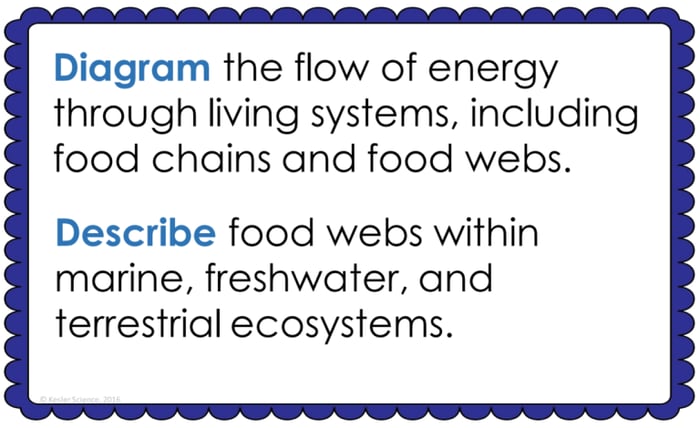FOOD WEBS LESSON PLAN – A COMPLETE SCIENCE LESSON USING THE 5E METHOD OF INSTRUCTION
At the end of this comprehensive food webs lesson plan, students will be able to diagram the flow of energy through living systems, including food chains and food webs. Students will also be able to describe food webs within marine, freshwater, and terrestrial ecosystems. Each lesson is designed using the 5E method of instruction to ensure maximum comprehension by the students.
The following post will walk you through each of the steps and activities from the food webs lesson plan.
ENGAGEMENT
Objective Introduction
At the beginning of the lesson, the class will do a Think-Pair-Share to discuss the objective.
Class Activity
The teacher will pass out organism signs to students and select a producer, primary secondary, tertiary, and sun card to come to the front of the room. The teacher will ask the class to place students in order, diagramming a whom eats whom situation. The teacher will then connect the chain by using different color yarn. The different colors represent the energy transferring from one level to the next. Continue this and create a second food chain.
Student Activity
Students will combine the food chains to create a food web. Students will scatter around the classroom. The person holding the sun card will hold one end of a ball of yarn and transfer energy to all the primary consumers. Primary consumers will then take a different color yarn and pass their energy to the secondary consumers. Finally, the secondary consumers will take the third color yarn and pass their energy to the tertiary consumers. Students will see that they created a food web. The teacher will help to clear any misconceptions about food webs. A major misconception is that students don't understand that a food chain or food web is all about the transfer of energy. Students might also not understand that the further up the food chain/web the less energy is available.
The teacher will help to clear any misconceptions about food webs. A major misconception is that students don't understand that a food chain or food web is all about the transfer of energy. Students might also not understand that the further up the food chain/web the less energy is available.
Estimated Class Time for the Engagement: 20-30 minutes
EXPLORATION
This student-centered station lab is set up so students can begin to explore food webs. Four of the stations are considered input stations where students are learning new information about food webs, and four of the stations are output stations where students will be demonstrating their mastery of the input stations. Each of the stations is differentiated to challenge students using a different learning style. You can read more about how I set up the station labs here.
EXPLORE IT!
Students will be working in pairs to recreate the engagement activity that they went over at the beginning of the food webs lesson. Students will have 2 images that they will be looking at. The first image will require the students to list 7 organisms that live within a desert ecosystem. Students will explain how those organisms are related. The second image is the same as the first, however, includes a desert ecosystem food web. Students will explain how plants get their energy, the direction of the arrows, and what would the impact be if the hawk was removed from the web.
WATCH IT!
At this station, students will be watching a 4-minute video describing how wolves change rivers. Students will then answer questions related to the video and record their answers on their lab station sheet. For example, name 2 impacts the wolves had on the deer population at Yellowstone, how did the re-introduction impact tree populations, and how wolves impacted the flow of rivers in Yellowstone.
RESEARCH IT!
The research station will allow students to get online and participate in an interactive website about food webs. Students will read about food webs and what a trophic level means. Students interact with a food web game where they will drag and drop organisms within an Antarctic food web template. Once students have placed cards, they can check their answers and will be given opportunities to fix mistakes. With each concept, students will answer a few questions to help make the research more concrete.
READ IT!
This station will provide students with a one page reading about food webs. In the reading students will discover what the term ecology means and methods of ecological interdependence. Students will also learn from the reading that the many relationships that occur in an ecosystem that allows organisms to thrive an survive. There are 4 follow-up questions that the students will answer to show reading comprehension of the subject.
ASSESS IT!
The assess it station is where students will go to prove mastery over the concepts they learned in the lab. The questions are set up in a standardized format with multiple choice answers. Some questions include: what impact would the food web have if one of its organisms is diseased? Students will also be using a diagram to answer questions about other impacts to food webs, what the arrow represents, how can you change the diagram to make it more accurate?
WRITE IT!
Students who can answer open-ended questions about the lab truly understand the concepts that are being taught. At this station, the students will be answering three questions like describing the impact of removing an organism from a food web, describe the flow of energy in a marine food web, and explain the reason why humans are dependent on a healthy ecosystem.
ILLUSTRATE IT!
Your visual students will love this station. Students will be creating a sample food web from an ecosystem they would find at a nearby park. Students will include the Sun, at least 7 organisms and arrows depicting the flow of energy.

ORGANIZE IT!
The organize it station allows your students to place organisms on a food web template. The marine food web contains 9 cards that students will place in the correct order showing the correct flow of energy.
Estimated Class Time for the Exploration: 1-2, 45 minute class periods
EXPLANATION
The explanation activities will become much more engaging for the class once they have completed the exploration station lab. During the explanation piece, the teacher will be clearing up any misconceptions about food webs with an interactive PowerPoint, anchor charts, and interactive notebook activities. The food webs lesson includes a PowerPoint with activities scattered throughout to keep the students engaged.

The students will also be interacting with their journals using INB templates for food webs. Each INB activity is designed to help students compartmentalize information for a greater understanding of the concept. The food webs INB template will diagram the flow of energy that takes place in a terrestrial, freshwater, and marine ecosystem.Estimated Class Time for the Exploration: 2-3, 45 minute class periods
ELABORATION
The elaboration section of the 5E method of instruction is intended to give students choice on how they can prove mastery of the concept. When students are given choice the ‘buy-in’ is much greater than when the teacher tells them the project they will have to create. Each of the food web projects will allow students to show their understanding of the flow of energy transfer from organism to organism.
Estimated Class Time for the Elaboration: 2-3, 45 minute class periods (can also be used as an at-home project)
EVALUATION
The final piece of the 5E model is to evaluate student comprehension. Included in every 5E lesson is a homework assignment, assessment, and modified assessment. Research has shown that homework needs to be meaningful and applicable to real-world activities in order to be effective. When possible, I like to give open-ended assessments to truly gauge the student’s comprehension.
Estimated Class Time for the Elaboration: 1, 45 minute class period
DOWNLOAD THE FULL LESSON NOW
The full lesson is available for download from the Kesler Science Store. Save yourself a ton of time and grab it now.
Download Over $100 in FREE Resources
For Middle School Science
Simply create a login below and gain immediate access to a selection of our Kesler Science product line worth $100 - for FREE. There's a full version of every product type! You'll also join tens of thousands of middle school science teachers who receive timely tips and strategies straight to their inbox.





